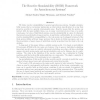686 search results - page 93 / 138 » System model for UML -- The interactions case |
114
click to vote
CANDC
2009
ACM
14 years 7 months ago
2009
ACM
Supporting users' reasoned imagination in sense making during interaction with tangible and embedded computation involves supporting the application of their existing mental ...
KBSE
2005
IEEE
15 years 3 months ago
2005
IEEE
Major software development standards mandate the establishment of trace links among software artifacts such as requirements, architectural elements, or source code without explici...
104
click to vote
IANDC
2007
14 years 10 months ago
2007
We define reactive simulatability for general asynchronous systems. Roughly, simulatability means that a real system implements an ideal system (specification) in a way that pre...
ISWC
2000
IEEE
15 years 2 months ago
2000
IEEE
If a wearable device can register what the wearer is currently doing, it can anticipate and adjust its behavior to avoid redundant interaction with the user. However, the relevanc...
102
click to vote
CODES
2007
IEEE
15 years 1 months ago
2007
IEEE
System-level and Platform-based design, along with Transaction Level modeling (TLM) techniques and languages like SystemC, appeared as a response to the ever increasing complexity...

